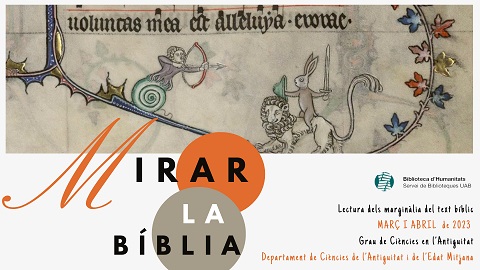Look at the Bible. Reading of the marginalia of the biblical text

We have a new expanded edition of the exhibition catalog "Looking at the Bible. Reading the marginalia of the biblical text", curated by Óscar de la Cruz Palma (Dep. Sciences of Antiquity and the Middle Ages) and Jordi Vidal Palomino ( Dept. Sciences of Antiquity and the Middle Ages).
07/03/2023
This exhibition is part of the educational activity that takes place within the space of the subject "Bible. Origins and tradition" of the Degree program in Ancient Sciences (UAB). Collect a sample that is illustrated with the projection of a video made by Óscar de la Cruz. In addition, the catalog raisonné of the exhibition explains its contents and collects the images that appear there. The students of the subject have been invited to participate, through the writing of worksheets.
The focus falls on the images that appear in copies of the Bible, from any era. But we pay special attention to the marginalia, a series of drawings that do not present a direct illustration with the biblical contents. On the other hand, the attempt to understand these marginalia and to want to justify their appearance, is an enormously formative task, because it requires studying multiple sources.
Dealing with the marginalia of biblical specimens is just a small sample of the enormous possibility of studies that can be done on the reading of the Bible. On the other hand, for being a subject in which the image is the protagonist, it lends itself willingly to being the reason for an exhibition. In addition, the obvious appeal of the subject serves as a propaedeutic for biblical studies. During the elaboration of the motif, the selection of images, the pretension to offer an explanation and the study of the tradition in which they are incorporated, reveal the marginalia as a much more complex subject than that of their aesthetic value. The most common is to find them interpreted as jokes, as pranks, an idea that does not need to be discussed. In fact, they are also for us, today's readers, at least in the sense that we find the marginalia as a kind of assault on the eyes that still motivates surprise and a smile, a silent laugh. Almost instantly to this reaction the problem appears: what is this image doing here, this monster, this mermaid, this little animal, this dragon, this crane, this flourish of colors and nested lines?
The conclusions are revealing. The marginalia are not only an aesthetic element: they attract the reader's attention, even with messages of social criticism, but not to entertain him, but on the contrary, to pour him into the text he is reading and invite him to its rereading, to its "correct" interpretation, in accordance with the prevailing moral sense. Marginalia function like glosses, like comments. Being on the page, they are part of the book and, materially, they are equivalent to a text. They are paratexts, as are the elements that index a work, added titles or marginal glosses. When you have a Bible with marginalia in your hands, you have a commented Bible. Not only to be read, but understood, admired and even contemplated. But these reactions must be recognized as parts of the Bible reading system called lectio divina. The biblical specimens, then, beautifully illuminated and with marginalia, turn out to be spiritual catalysts, nothing less than a kind of channels to travel through the correct interpretation of the Biblical text, be it complete or partial, such as the Gospels, the Psalters and, by extension, the Books of Hours. The marginalia are not a devotional object, as the illuminations can be, but they contribute to the devotional reading of the text. The marginalia, in a way, are text or, if you don't want to say it that way, they involve a rhetoric, built, obviously, with images, not with words. Images that are not verbalized, a silent reading.
A Bible with marginalia (including the Psalters and the Books of Hours) is, finally, a Bible commented on and prepared for spiritual reading, and, however cute its drawings may be, perfectly favorable to lectio divina.
Exhibition Curators:
Óscar de la Cruz Palma (Dep. Ciències de lʼAntiguitat i de lʼEdat Mitjana)
Jordi Vidal Palomino (Dep. Ciències de lʼAntiguitat i de lʼEdat Mitjana)
The exhibition catalog is included as a training activity linked to the subject «Bible. Origins and tradition» of the program of the Degree in Antiquity Sciences (UAB).
This information is related to the following SDG
Quality education